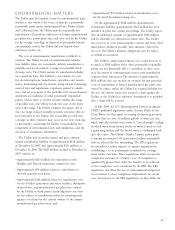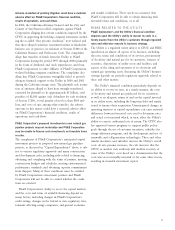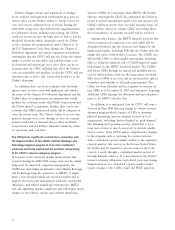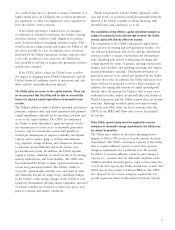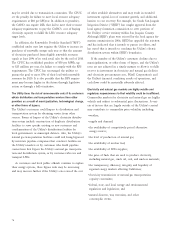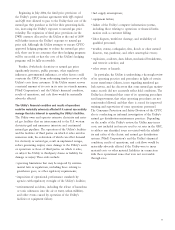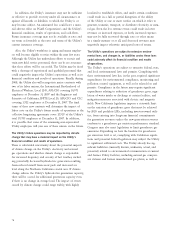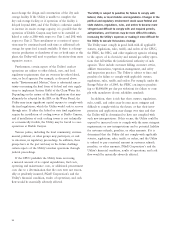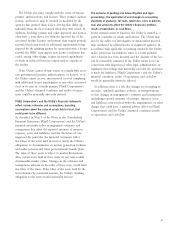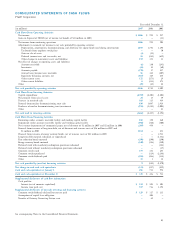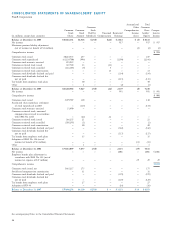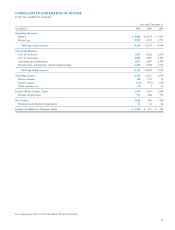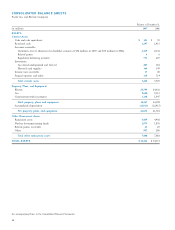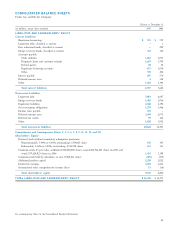PG&E 2007 Annual Report Download - page 81
Download and view the complete annual report
Please find page 81 of the 2007 PG&E annual report below. You can navigate through the pages in the report by either clicking on the pages listed below, or by using the keyword search tool below to find specific information within the annual report.79
at third-party owned sites. The Utility’s environmental com-
pliance and remediation costs could increase, and the timing
of its future capital expenditures may accelerate, if standards
become stricter, regulation increases, other potentially respon-
sible parties cannot or do not contribute to cleanup costs,
conditions change, or additional contamination is discovered.
In the event the Utility must pay materially more than
the amount that it currently has accrued on its Consolidated
Balance Sheets to satisfy its environmental remediation
obligations and cannot recover those or other costs of
complying with environmental laws in its rates in a timely
manner, or at all, PG&E Corporation’s and the Utility’s
fi nancial condition, results of operations, and cash fl ow
would be materially adversely affected.
The operation and decommissioning of the Utility’s nuclear
power plants expose it to potentially signifi cant liabilities and
capital expenditures that it may not be able to recover from
its insurance or other source, adversely affecting its fi nancial
condition, results of operations, and cash fl ow.
Operating and decommissioning the Utility’s nuclear power
plants expose it to potentially signifi cant liabilities and capi-
tal expenditures, including not only the risk of death, injury,
and property damage from a nuclear accident, but matters
arising from the storage, handling, and disposal of radio-
active materials, including spent nuclear fuel; stringent safety
and security requirements; public and political opposition
to nuclear power operations; and uncertainties related to the
regulatory, technological, and fi nancial aspects of decommis-
sioning nuclear plants when their licenses expire. The Utility
maintains insurance and decommissioning trusts to reduce
the Utility’s fi nancial exposure to these risks. However, the
costs or damages the Utility may incur in connection with
the operation and decommissioning of nuclear power plants
could exceed the amount of the Utility’s insurance coverage
and other amounts set aside for these potential liabilities.
In addition, as an operator of two operating nuclear reactor
units, the Utility may be required under federal law to
pay up to $201.2 million of liabilities arising out of each
nuclear incident occurring not only at the Utility’s Diablo
Canyon facility, but at any other nuclear power plant in
the United States.
The NRC has broad authority under federal law to
impose licensing and safety-related requirements upon
owners and operators of nuclear power plants. If they do
not comply, the NRC can impose fi nes or force a shutdown
of the nuclear plant, or both, depending upon the NRC’s
assessment of the severity of the situation. NRC safety and
security requirements have, in the past, necessitated substan-
tial capital expenditures at Diablo Canyon and additional
signifi cant capital expenditures could be required in the
future. If one or both units at Diablo Canyon were shut
down pursuant to an NRC order, or to comply with NRC
licensing, safety or security requirements, or due to other
safety or operational issues, the Utility’s operating and main-
tenance costs would increase. Further, such events may cause
the Utility to be in a short position and the Utility would
need to purchase electricity from more expensive sources.
In addition, the Utility’s nuclear power operations are
subject to the availability of adequate nuclear fuel supplies
on terms that the CPUC will fi nd reasonable. Although
the Utility has entered into several purchase agreements for
nuclear fuel, with terms ranging from one to thirteen years,
there is no assurance the Utility will be able to enter into
similar agreements in the future on terms that the CPUC
will fi nd reasonable.
The NRC operating licenses for Diablo Canyon require
suffi cient storage capacity for the radioactive spent fuel it
produces. Under current operating procedures, the Utility
believes that the existing spent fuel pools have suffi cient
capacity to enable the Utility to operate Diablo Canyon
until approximately 2010 for Unit 1, and 2011 for Unit 2.
After receiving a permit from the NRC in March 2004, the
Utility began building an on-site dry cask storage facility to
store spent fuel through at least 2024. The Utility estimates
it could complete the dry cask storage and begin loading
spent fuel in 2008. The NRC is still considering issues that
were raised by various parties who appealed the NRC’s
issuance of the permit. (See “Regulatory Matters — Spent
Nuclear Fuel Storage Proceeding” above.) The Utility may
incur signifi cant additional capital expenditures or experi-
ence schedule delays if the NRC decides that the Utility


